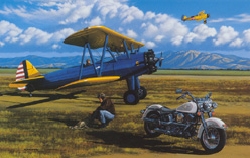|
|
| Two Ways to Fly |
|
 |

|
 |
|
|
| DESCRIPTION |
 |
| 16 x 11.5 Inch Collector Size Unframed Lithograph $40.00
Lloyd Stearman was a Naval Aviator and former architecture student who moved from Wichita Kansas to Venice California in 1926 to set up his own aircraft manufacturing company. Stearman did business under the motto "Dedicated to the Discriminating Buyer" and given the test of time we can now certainly say that Stearman's customers got their money's worth. Stearman moved his business to Kansas in 1927 and partially due to the publicity surrounding Lindbergh's transatlantic flight encountered strong demand for his C-3MB biplanes. These aircraft were utilized by both American and Varney Air Lines to provide mail service. In 1929 Stearman's high end model was the C-3R which was powered by a 225HP Wright engine and carried a price tag of $8000. Stearman sold his company to the large aviation conglomerate United Aircraft and Transport in 1929. Shortly thereafter the depression had set in and its devastating grip on the nation created very difficult business conditions for all companies in the aviation business especially those manufacturing aircraft. Stearman left the company which bears his name in 1932 and shortly thereafter became President of Lockheed. The classic aircraft which today bears his name was actually designed in 1933 following his departure and was produced in quantity by Boeing Aircraft which purchased the Stearman Division of United Aircraft in 1934 as a result of a government mandated antitrust settlement. The PT-13 or Kaydet was selected by the both the Army and the Navy as its primary trainer. (This may have been the first time in history that the two major branches of the service had agreed upon anything.) More than 10000 Stearmans were produced. Most common was the PT-17 which was powered by 220HP Continental rotary engines. This rugged little machine was ideal for training first time pilots and its undercarriage was ideally-designed for absorbing the punishment of first time practice landings. The Navy referred to its Stearmans as N2S's and with an all yellow paint job the Navy version was soon nicknamed the "yellow peril." Reportedly the term "peril" a reference to the piloting skills of the cadets being trained. The Army opted for a paint scheme utilizing a blue fuselage and yellow wings. At the end of WW II thousands of Stearmans were sold at surplus some for as little as $200. The aircraft in one of its second incarnations became America's primary crop duster. The sturdy airframe being easily adapted to take on more powerful engines and chemical tanks. In another incarnation the Stearman became a much sought after aerobatics performer. A significant number of these aviation classics are still flying and can be regularly seen at air shows throughout the nation. In his painting appropriately entitled Two Ways to Fly aviation artist Stan Stokes depicts a PT-17 Stearman and a vintage Harley-Davidson motorcycle at a dirt field typical of those across the nation where tens of thousands of pilots and aviation enthusiasts have been introduced to the joys of flight. |
|


|